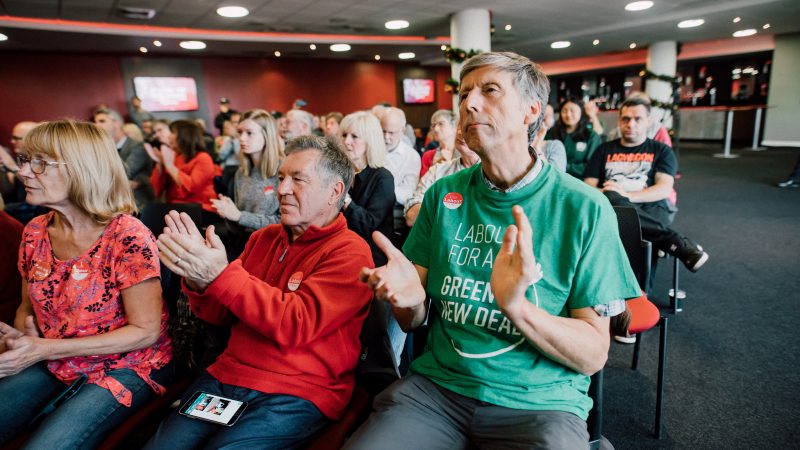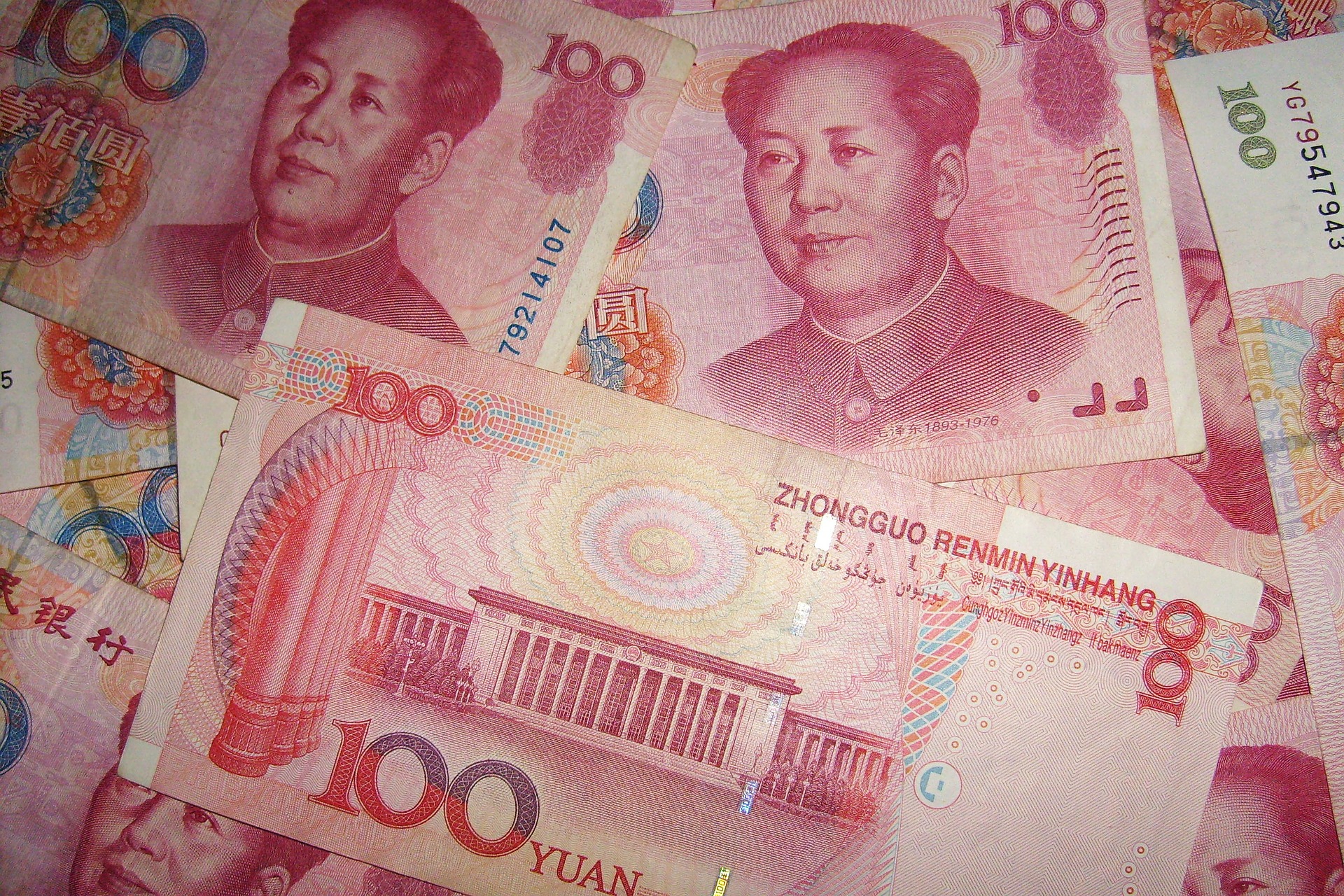UK
Labour for a Green New Deal policy motion backed by conference

Delegates at the Labour Party’s annual conference have backed a policy motion calling on the party to back a “socialist green new deal” advocated by campaign organisation Labour for a Green New Deal this afternoon.
The motion was also promoted by the Transport Salaried Staffs’ Association (TSSA) and the Fire Brigades Union (FBU), together with the majority of local parties that submitted environmental motions. It was passed by a show of hands.
Dozens of motions on the climate emergency were submitted ahead of Labour conference this year, including 25 that used the Labour for a Green New Deal model motion.
GMB put forward a counter proposal at a compositing meeting on Saturday, the process whereby party figures, motion backers and affiliates negotiate over wording. Its separate motion calls for investment in new nuclear plants and “green gases”.
Update, 2.20pm: A show of hands in the conference hall for the GMB-backed green new deal motion was too close to call. A card vote was called and the motion was passed with 59.21% in favour. A full breakdown of the vote is expected on Monday.
The trade union’s motion appears to soften support for nationalising energy companies, saying instead: “Public and alternative forms of ownership will be necessary to tackle climate and environmental breakdown.”
Whereas the first composite motion, from the Labour for a Green New Deal campaign group, calls for “public ownership of energy including energy companies, creating an integrated, democratic system”.
Commenting after the vote, Momentum co-chair Gaya Sriskanthan said: “This is a turning point. The grassroots have had enough of timid centrism and have overwhelmingly endorsed transformative socialist policy that meets the crises of the 21st century head on.
“From the public ownership of the energy sector to the creation of a national care service and millions of green jobs, this motion gives us a clear vision of what a just transition under a Labour government would look like.”
Labour for a Green New Deal co-founder Chris Saltmarsh said in response to the result that Starmer “should restate the ambitious pledges of his leadership campaign, and put the Green New Deal at the heart of his agenda”.
“This result shows that there is huge support for a radical agenda in the Labour Party, and that the membership and affiliated unions are united in their support for transformative politics.”
Labour Conference’s backing for the future of hundreds of thousands of energy workers will be welcomed in working class communities across our regions and nations.
Commenting after the result of the card vote on composite motion two was announced, Gary Smith said: “We support a green new deal but it can’t be based on running down industries and making tens of thousands redundant – that’s not how you take workers and their communities with you.”
The GMB general secretary described the creation of low-carbon jobs through the opening of new nuclear power plants as, and “recognising the realities of the UK’s gas needs in the grip of a growing energy crisis”, as “vital”.
He added: “The Labour Party Conference has taken a big step forward towards ensuring that climate justice and economic justice go hand in hand as the UK plays its part in tackling the climate crisis.”
Below is the full text of both green new deal composite motions.
Green new deal one – composite one
Conference notes:
- As with Covid, the climate crisis exposes sharply the inequalities in society in the UK and internationally and we must ensure that workers are at the heart of any future programme and that means unshackling trade unions.
- The UK faces a post-covid unemployment crisis with insecurity and lowpay rife for workers.
- Intensifying climate and environmental breakdown brings devastating threats to public health and livelihoods.
- The UN’s latest climate report states that temperatures are likely to rise by more than the vital 1.5C limit in the next two decades, bringing widespread devastation and extreme weather.
- That only immediate, rapid and large-scale reductions in emissions can prevent such breakdown.
16 - Local communities in the UK and countries around the world are experiencing climate change related extreme weather events, including devastating flooding, wildfires, hurricanes, and droughts. This is with warming at 1.2°C above average pre-industrial levels. Currently, we are headed for a 2.9°C temperature increase.
- Keir Starmer has pledged to hardwire the socialist Green New Deal into everything we do.
- The UK spends billions of pounds per year on fossil fuel subsidies and is a key jurisdiction for the enforcement of globally accrued debt.
Conference believes:
- Ahead of COP26, Labour should promote a just, green recovery combining efforts to address unemployment, climate change, and public health.
- The Tory government is posturing on climate change with no serious plan to meet its climate targets. It has cut Green Home Grants and paid £40bn fossil fuels subsidies since March 2020 alone.
- Privatisation has undermined decarbonisation and pandemic response measures.
- The Covid Pandemic has shown that the levers of the state are required to respond to crises.
- Debt relief is essential to achieve climate justice.
Resolves to support:
- The socialist Green New Deal that will shift power from capital into the hands of workers .
Public ownership of energy including energy companies, creating an integrated, democratic system. - A government program creating millions of well-paid, unionised green jobs with publicly owned entities
Creating well-financed publicly owned national and regional green investment banks.
Mass investment in green technologies and renewables; - A just transition with a comprehensive re-training program and green job guarantee on union rates for affected workers.
- A just transition for British steelworkers, through sustained investment to decarbonise the steel industry
- Expansion and electrification of integrated public transport, including public ownership of our railways; free local bus networks, rail electrification, highspeed rail, sustainably powered rail freight and electric buses;
- Just climate adaptation, investing in fire and rescue services, flood defences, and resilient infrastructure;
- Retrofitting all homes to the highest standard of energy efficiency
- The creation of a National Climate Service, similar to creation of our NHS by Labour in 1948, to now tackle the crisis facing our planet
- Subsidies to support a comprehensive investment programme in renewable energy, home retrofit and zero carbon homes, decarbonisation of industry and transport, and nature restoration.
- Universal basic services, including a national care service
- Gearing education and training to climate transition.
- Banning fracking.
- National Nature service including ten new national parks, strategic rewilding, land regeneration, and particularly the restoration of upland bogs.
- Agricultural transition with the contribution regenerative farmers make by capturing carbon, managing water and promoting biodiversity to be recognised with funding
- Repealing all anti-trade union laws so workers can freely take industrial action over wider social and political issues, for industrial action to ensure action on climate change.
- Workers organising to decarbonise industries and the global supply chain.
- Using public procurement to promote decarbonisation, environmental protections, and international justice in global supply chains.
- All future stimulus and bailout eligibility linked to climate action and just transition plans;
- A global socialist Green New Deal, debt relief for low-income country debt held by UK institutions, financially assisting the transition in developing countries and freely sharing technology and resources internationally.
- Legal recognition of climate refugees’ right to asylum.
- Linking internationally with indigenous groups, trade unions and groups resisting ecological assault.
Green new deal two – composite two
Conference notes:
- Already 1.2°C of warming has taken place, causing floods, droughts and rising seas disproportionately impacting on developing countries.
- The IPCC August 2021 report is a ‘code red for humanity’ and that this is the significant decade for preventing catastrophic climate change by limiting global heating to below 1.5°C above pre-industrial levels.
- The COP26 Climate Change Conference in Glasgow this year may be the final opportunity for the world to slow and then reverse climate change.
- Intensifying climate and environmental breakdown bring devastating threats to public health and livelihoods.
- Even before the pandemic, air pollution represented a national health emergency resulting in an estimated 40,000 early deaths each year, costing the UK £20 billion annually.
- The UK also faces a post-Covid unemployment crisis with insecurity and lowpay rife for workers.
- Climate change is a global issue that requires international solutions, because this is as much a social injustice as an environmental one.
- The environmental cost of imported steel is greater than domestically produced steel, and any transition that does not keep steel in the UK is a false economy.
- Keir Starmer has pledged to hardwire the Green New Deal into everything we do.
- Labour councils lead on decarbonisation: Nottingham City has reduced per capita CO2 emissions by 52.3% since 2005 and aims to be carbon neutral by 2028.
Conference believes:
- Britain must cut the substantial majority of carbon emissions by 2030
- Policies must be developed with workers and trade unions, not imposed on them.
- In working with businesses to reduce their impact on the environment.
- In line with the ILO’s definition of a just transition, that ‘strong social consensus on the goal and pathways to sustainability is fundamental.’
- Privatisation has undermined decarbonisation and pandemic response measures.
- Public and alternative forms of ownership will be necessary to tackle climate and environmental breakdown.
- Ahead of COP26 Labour should promote a just, green recovery combining efforts to address unemployment, climate change, and public health.
- The UK’s pathway to 1.5°C needs a balanced and secure energy mix that includes renewables, nuclear, and the flexibility currently provided by gas and in future by fuels including hydrogen.
- Debt relief is essential to climate justice.
- We can solve the unemployment crisis and rapidly decarbonise with a Green New Deal creating secure, well-paid, unionised green jobs.
Conference resolves to support a just transition toward a low-carbon economy, including:
- Mass investment in green technologies, such as green gas;
- Expansion of public transport, and electrification;
- Just climate adaptation, including investing in fire and rescue services, flood defences, and resilient infrastructure;
- Upgrading homes to the highest standard of energy efficiency, including retrofitting and insulation.
- Agricultural transition and sustainable food policies, putting food and farming at the heart of the global response to the climate emergency.
- Establishing a legal right to breathe clean air by ensuring the law on air quality is at least as strict as WHO guidelines, with tough new targets, deadlines and duties on Ministers to enforce them and new powers for local authorities;
- A comprehensive training program;
- Creating well-financed publicly owned national and regional green investment banks;
- Using public procurement to promote decarbonisation, environmental protections, and international justice in global supply chains;
- New nuclear plants, including Sizewell C and Small Modular Reactors;
- Reform of international trade rules to better build up our domestic energy manufacturing sectors;
- Devolving powers to devolved and local authorities to support a just transition for workers;
- A global Green New Deal, sharing technology and resources internationally, bringing forward debt relief and financially assisting the transition in developing countries.










